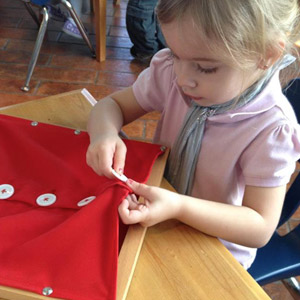
“A child’s work is to create the man he will become”
— Maria Montessori
Practical Life

The purpose of the practical life exercises in the Montessori environment is to satisfy the child’s need for meaningful activity. These exercises are based on the activities of daily life such as pouring a glass of juice or learning how to lace and tie ones shoes. These activities also prepare the child for the more complex activities in the classroom by helping the child to develop order, concentration, coordination, and independence.
Sensorial

The sensorial materials in the environment help the child to sharpen his senses so that he can better understand the impressions that he is receiving from the experiences in his world. The sensorial materials isolate one particular quality such as color, weight, shape, texture, size, smell and sound.
The sensorial materials help the child to categorize and to relate new information to what he already knows. The materials are also related to the language and math areas of the classroom. A child who has had experience with the sound cylinders will be able to hear the subtle differences in the sound of the letters and will be able to build and create words using specially designed material in the language area of the classroom. Math preparation plays a role throughout the sensorial area by using shape, gradation, and patterns the children are exploring some of the basis for math concepts.
Language

The language area of the environment is rich in oral language activities, exploration of letter sound and symbol, writing, reading and function of words. An example of letter sound and symbol comes from the child’s work with the sandpaper letters. This work allows the child to see the shape, to hear the sound and to feel the shape of the letter. By giving these impressions the child is then able see the relationship between sound and symbol and will then begin to put the sounds together to build words and then sentences.
Math

In this area of the classroom the child will learn math concepts by using concrete materials that will enhance the child’s ability to easily and joyfully obtain many facts and skills relating to arithmetic. The children will use materials for counting from 0 -10 and from there move onto concepts of linear counting, decimal system, addition, subtraction, multiplication, and division.
What is Montessori?

Montessori is a method of education that was developed by Dr. Maria Montessori. It was Montessori’s belief that the goal of early education should not be focused on filling the child with pre-selected information, but to to encourage his own natural desire to learn. In the Montessori environment the children are able to select activities based on their own natural curiosity and with the help of specially trained teachers the children are encouraged to explore, create, and fall in love with learning.
The Montessori Classroom
The Montessori environment is based on a multiage classroom. The preschool environment has children from 2 /12 to 6 years of age. Having a mixed age group allows the younger children a grade series of role models and lets the older children reinforce their own knowledge by helping younger peers. The environment is prepared by the teacher to be inviting and spark the child’s curiosity about the world around him. This is why the materials are graded in such a way that it allows the child to grow from one level of complexity to another in a natural progression.



